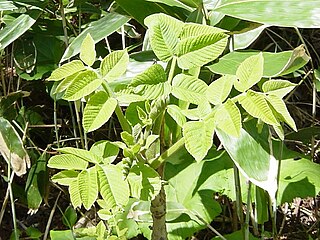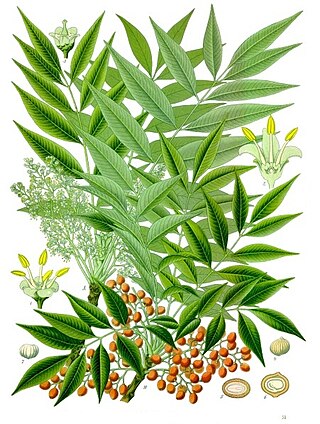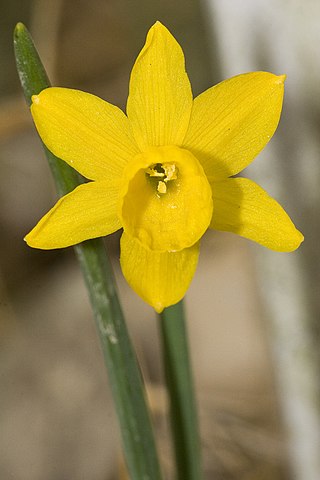
Toxicodendron is a genus of flowering plants in the sumac family, Anacardiaceae. It contains trees, shrubs and woody vines, including poison ivy, poison oak, and the lacquer tree. All members of the genus produce the skin-irritating oil urushiol, which can cause a severe allergic reaction. The generic name is derived from the Greek words τοξικός (toxikos), meaning "poison," and δένδρον (dendron), meaning "tree". The best known members of the genus in North America are poison ivy (T. radicans), practically ubiquitous throughout most of eastern North America, and western poison oak, similarly ubiquitous throughout much of the western part of the continent.

Toxicodendron radicans, commonly known as eastern poison ivy or poison ivy, is an allergenic flowering plant that occurs in Asia and eastern North America. The species is well known for causing urushiol-induced contact dermatitis, an itchy, irritating, and sometimes painful rash, in most people who touch it. The rash is caused by urushiol, a clear liquid compound in the plant's sap. The species is variable in its appearance and habit, and despite its common name, it is not a true ivy (Hedera), but rather a member of the cashew and pistachio family (Anacardiaceae). T. radicans is commonly eaten by many animals and the seeds are consumed by birds, but poison ivy is most often thought of as an unwelcome weed. It is a different species from western poison ivy, T. rydbergii, which has similar effects.

Sumac or sumach is any of about 35 species of flowering plants in the genus Rhus and related genera in the cashew family (Anacardiaceae). Sumacs grow in subtropical and temperate regions throughout every continent except Antarctica and South America. Sumac is used as a spice, as a dye, and in medicine.

Toxicodendron diversilobum, commonly named Pacific poison oak or western poison oak, is a woody vine or shrub in the sumac family, Anacardiaceae. It is widely distributed in western North America, inhabiting conifer and mixed broadleaf forests, woodlands, grasslands, and chaparral biomes. Peak flowering occurs in May. Like other members of the genus Toxicodendron, T. diversilobum causes itching and allergic rashes in most people after contact by touch or smoke inhalation. Despite its name, it is not closely related to oaks, nor is it a true tree.
Poison oak refers to two plant species in the genus Toxicodendron, both of which can cause skin irritation:

Toxicodendron vernix, commonly known as poison sumac, or swamp-sumach, is a woody shrub or small tree growing to 9 metres (30 feet) tall. It was previously known as Rhus vernix. This plant is also known as thunderwood, particularly where it occurs in the southern United States. All parts of the plant contain a resin called urushiol that causes skin and mucous membrane irritation to humans. Urushiol is the same chemical that poison ivy is covered in. When the plant is burned, inhalation of the smoke may cause the rash to appear on the lining of the lungs, causing extreme pain and possibly fatal respiratory difficulty.

Rhus typhina, the staghorn sumac, is a species of flowering plant in the family Anacardiaceae, native to eastern North America. It is primarily found in southeastern Canada, the northeastern and midwestern United States, and the Appalachian Mountains, but it is widely cultivated as an ornamental throughout the temperate world. It is an invasive species in some parts of the world.

Toxicodendron vernicifluum, also known by the common name Chinese lacquer tree, is an Asian tree species of genus Toxicodendron native to China and the Indian subcontinent, and cultivated in regions of China, Japan and Korea. Other common names include Japanese lacquer tree, Japanese sumac, and varnish tree. The trees are cultivated and tapped for their toxic sap, which is used as a highly durable lacquer to make Chinese, Japanese, and Korean lacquerware.
Inga calcicola is a species of plant in the family Fabaceae. It is found only in Mexico.
Ormocarpopsis calcicola is a species of flowering plant in the family Fabaceae. It is found only in Madagascar.

Madhuca calcicola is a species of plant in the family Sapotaceae. It is a tree endemic to Peninsular Malaysia. It is threatened by habitat loss.
Myrcia calcicola is a species of plant in the family Myrtaceae. It is endemic to Jamaica and is threatened by habitat loss.
Toxicodendron delavayi is a species of plant in the family Anacardiaceae. It is endemic to China. It is threatened by habitat loss.
Shorea calcicola is a species of plant in the family Dipterocarpaceae. It is endemic to Borneo. The species name is derived from Latin and refers to the preferred habitat of this species. It is a medium-sized tree, usually less than 50 metres (160 ft) tall, found in mixed dipterocarp forest on organic soils over limestone.

Toxicodendron succedaneum, the wax tree, Japanese Hazenoki tree (Sumac or wax tree), sơn in Vietnam or charão in Portuguese, is a flowering plant species in the genus Toxicodendron found in Asia, although it has been planted elsewhere, most notably Australia and New Zealand. It is a large shrub or tree, up to 8 m tall, somewhat similar to a sumac tree. Because of its beautiful autumn foliage, it has been planted outside Asia as an ornamental plant, often by gardeners who were apparently unaware of the dangers of allergic reactions. It is now officially classified as a noxious weed in Australia and New Zealand. It is one of the city tree symbols of Kurume, Fukuoka, Japan.

Narcissus calcicola is a species of narcissus (daffodils) in the family Amaryllidaceae. It is classified in Section Apodanthi. It is endemic to Portugal.

Eucalyptus calcicola, commonly known as the Boranup mallee, Harry Butler's mallee or Hamelin Bay mallee, is a mallee that is endemic to a small area in the south-west of Western Australia. It has smooth, pale greenish bark, lance-shaped to curved adult leaves, flower buds in groups of seven or nine, white flowers and ribbed, cup-shaped to hemispherical fruit.

Daphne aurantiaca is a shrub of the family Thymelaeaceae. It is native to China, specifically Sichuan and Yunnan.
Grevillea calcicola is a species of flowering plant in the family Proteaceae and is endemic to the north-west of Western Australia. It is a much-branched shrub with pinnatisect leaves with linear lobes, and off-white to cream-coloured flowers.
Magnolia fulva is a species of flowering plant in the family Magnoliaceae, native to south-central China and Vietnam. It was first described, as Michelia fulva, in 1987.












